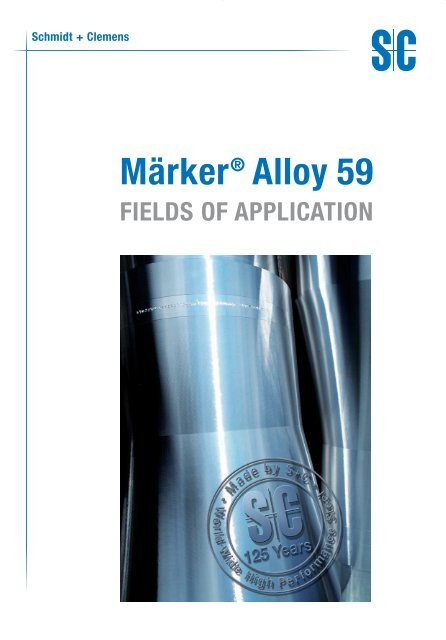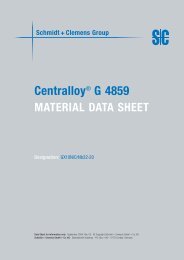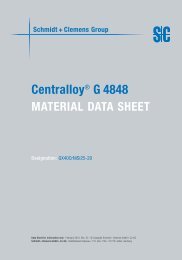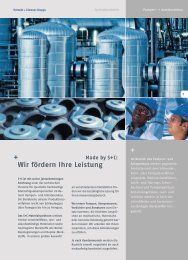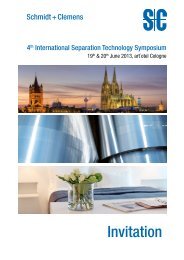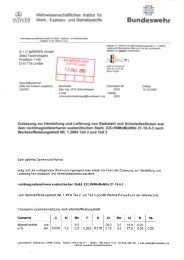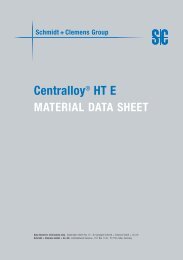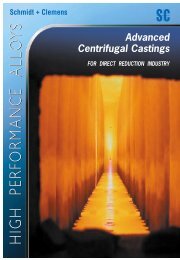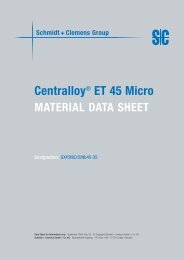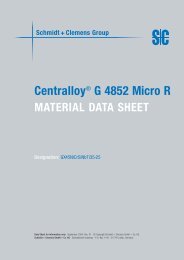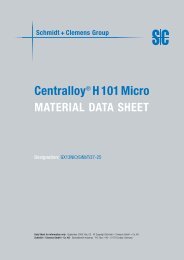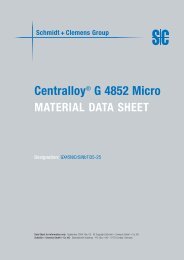Märker® Alloy 59 - Schmidt+Clemens
Märker® Alloy 59 - Schmidt+Clemens
Märker® Alloy 59 - Schmidt+Clemens
Create successful ePaper yourself
Turn your PDF publications into a flip-book with our unique Google optimized e-Paper software.
Schmidt + Clemens<br />
Märker ® <strong>Alloy</strong> <strong>59</strong><br />
FIELDS OF APPLICATION
G-NiCr23Mo16<br />
Märker ® <strong>Alloy</strong> <strong>59</strong> – Fields of Application<br />
Shutoff and Fluid Control devices, Feed Pumps and<br />
Agitators in Inorganic and Organic Chemistry Plants well as<br />
in the Pharmaceutical Industry<br />
These plants mainly process aqueous solutions because they are<br />
easy to transport and to measure out. In the majority of cases,<br />
aqueous solutions of inorganic substances are solutions of salts<br />
that contain chloride or sulphite/sulphate and those of organic<br />
substances are solutions based on acetic or formic acid as well<br />
as sulphonic acid.<br />
High-select super alloy materials such as “Märker <strong>Alloy</strong> <strong>59</strong>” are<br />
employed in these plants whenever there is the challenge of high<br />
concentrations of these substances or high temperature ranges,<br />
i.e. where standard or high-grade stainless steel does not provide<br />
adequate resistance.<br />
In pharmaceutical plants, rather than the substances actually<br />
processed, it is the solutions used to clean the plants at mostly<br />
increased temperatures that are aggressive.<br />
The same applies to so-called “multi-purpose plants” where different<br />
chemicals are processed at alternatively because it would<br />
not pay to construct individual plants for each substance<br />
involved.<br />
For process equipment and pipe work systems, semi-finished<br />
products made of <strong>Alloy</strong> <strong>59</strong> (2.4605) shaped as plates, rods or<br />
seamless and/or longitudinally welded tubes are available from<br />
the product range of ThyssenKrupp VDM GmbH.<br />
As a matter o fact, to produce the components of pumps and<br />
valves that come into contact with the aggressive medium, from<br />
forgings is mostly impossible or, if at all, would involve a lot of<br />
time, work and money.<br />
Schmidt + Clemens have therefore acquired the licence to manufacture<br />
mould casting components made from this alloy. S+C<br />
are able to supply individual components as well as volume production<br />
parts by the sand, investment or precision casting technique<br />
either as rough or part-finished castings in accordance<br />
with the delivery instructions of the components manufacturers.<br />
For reasons outlined above it is also difficult to produce mechanical<br />
seals or glands that will resist this type of corrosion. Consequently,<br />
these plants commonly employ glandless pumps (canned<br />
motor pumps) and bellows valves.<br />
In pharmaceutical plants, the surface of the castings is required<br />
to meet even more severe requirements. It is, therefore, common<br />
to apply the precision casting technique with its rather inherent<br />
high surface finish (to be electro-polished, if necessary) which<br />
does not provide any problems during sterilisation.<br />
The following schematic diagram of a chemical plant is intended<br />
to illustrate which pumps or valves S+C can supply components<br />
for that comply with the requirements specified above.<br />
2 <strong>Alloy</strong> <strong>59</strong>
Shutoff and Fluid Control devices, Feed Pumps and<br />
Agitators in Inorganic and Organic Chemistry Plants well as<br />
in the Pharmaceutical Industry (Examples)<br />
<strong>Alloy</strong> <strong>59</strong> 3
G-NiCr23Mo16<br />
Märker ® <strong>Alloy</strong> <strong>59</strong> – Fields of Application<br />
Flue Gas Cleaning Plants for Coal-fired Power Stations<br />
and Waste Incineration Plants: Shutoff and Control Devices,<br />
Agitator Propellers, Fan Blades<br />
In flue gas cleaning plants, after the gases have cooled down,<br />
corrosive constituents are washed out with fluids that bind these<br />
constituents, thereby enabling their discharge as slurry, dissolved<br />
salts or acids.<br />
As a general rule, sulfur compounds (sulfates) are bound to<br />
gypsum by means of lime milk and, in special cases, brought to<br />
oxidize into SO 3 and dissolved in water as diluted sulfuric acid.<br />
Likewise, chlorides are bound by means of alkaline solutions<br />
(CaOH or NaOH) and discharged as salts.<br />
Where metallic materials are used in the scrubbers, their permanent<br />
resistance to pitting and crevice corrosion as well as to<br />
stress corrosion cracking is a decisive factor for selecting the<br />
appropriate material. These types of corrosion are potentially<br />
hazardous not only in the high temperature range but also at low<br />
temperatures that fall below the dew point of the flue gases, thus<br />
creating higher chloride concentrations.<br />
As a matter of fact, flue gas cleaning plants are chemical facilities<br />
with special feedstock and, therefore, require materials for<br />
fans, valves and agitator propellers that are designed to be<br />
resistant to the contact medium.<br />
In view of their size, these components must be manufactured<br />
as castings.<br />
The Nickel-based alloy Märker <strong>Alloy</strong> <strong>59</strong> proved to be particularly<br />
effective in facilities downstream of lignite power stations<br />
because this fuel shows high salt contents, i.e. apart from sulfur,<br />
contains major quantities of chlorides.<br />
The same applies to flue gases in special waste incineration<br />
plants where chlorinated plastic material and industrial wastes,<br />
e.g. from hospitals, are disposed of.<br />
The gypsum generated as part of the procedure is separated<br />
from the effluents coming from the scrubber in the waste water<br />
treatment plant. The residual water containing dissolved chlorides<br />
and other hazardous matter is chemically treated before<br />
evaporation.<br />
The high temperatures and chloride concentrations generated in<br />
this process also require the use of Nickel-based alloys such as<br />
Märker <strong>Alloy</strong> <strong>59</strong> in pumps and valves.<br />
4 <strong>Alloy</strong> <strong>59</strong>
Organic Acids and Media<br />
Inorganic Acids<br />
Citric Acid<br />
To recover citric acid from bio cultures, it is first converted to calcium<br />
citrate, filtered and brought into contact with highly concentrated<br />
sulphuric acid. In this mixture of 95 to 99 % sulphuric acid,<br />
Märker <strong>Alloy</strong> <strong>59</strong> can be employed whilst it would not be resistant<br />
to pure sulphuric acid at such high concentrations.<br />
Acetic acid<br />
In a number of procedures, organic compounds are used as<br />
acetic acid ester to facilitate subsequent processing. In the<br />
majority of cases, industrial acetic acids contain traces of formic<br />
acid, sulphuric acid, chlorides such as FeCl 3 that have an oxidizing<br />
effect, or atmospheric oxygen.<br />
These additives considerably increase the susceptibility to corrosion,<br />
thus requiring materials superior to the 6 % Mo special<br />
stainless steels.<br />
The same applies to minor percentages of acetic acid anhydride<br />
in chemical reactions.<br />
Oil and Gas Production – Cooling Circuits<br />
On offshore platforms and frequently also in onshore facilities,<br />
seawater is the medium of choice for cooling. The cooling water<br />
is chlorinated to prevent algae growth in the system. However,<br />
this significantly increases the risk of pitting and crevice corrosion<br />
mainly in welded and flanged connections.<br />
Particularly in the sealing faces of flanges, the most severe<br />
crevice corrosion conditions appear.<br />
Besides the choice of the appropriate metallic material, the<br />
correct selection of sealing materials influences the corrosion<br />
resistance.<br />
For safety reasons and independent of the chloride concentrations,<br />
the US marine prescribes the use of <strong>Alloy</strong> <strong>59</strong>.<br />
Accordingly, all components that come into contact with the<br />
medium, such as pumps and valves, but also all connecting<br />
flanges, must be made from equivalent material.<br />
Sulphuric, Hydrochloric Acid, Phosphoric Acid<br />
The diagrams shown on page 6 of the material data sheet<br />
demonstrate that the Märker <strong>Alloy</strong> <strong>59</strong> material is ideal for use<br />
throughout various ranges of temperature and concentration.<br />
These acids are commonly used in chemical processes and primarily<br />
employed to dissolve minerals and as reactants for intermediate<br />
products.<br />
On account of the fact that these acids are frequently left over<br />
once the processes are terminated they are recovered in evaporator<br />
plants where increasing concentrations are pumped<br />
through evaporators.<br />
For many of these pumps and valves, castings made from Märker<br />
<strong>Alloy</strong> <strong>59</strong> have proved to be the optimum solution.<br />
Aluminium Reprocessing<br />
Melting aluminium waste leaves a layer of sodium and potassium<br />
salts to protect the molten metal against oxidation.<br />
To recover the aluminium contained in the salts they are dissolved<br />
in water by means of ammonium chloride and re-crystallized.<br />
The process solution contains 20 to 25 % NaCl, 6 to 8 % KCl, and<br />
5 to 8 % NH4Cl, pH value 4.5 to 6 at 170 °C.<br />
After 3,800 hours of exposure, Märker <strong>Alloy</strong> <strong>59</strong> proved to be the<br />
only material that did not show any corrosion.<br />
Copper melting Furnace<br />
Sulphur dioxide-enriched exhaust gases are cleaned in 55 sulphuric<br />
acid at 45 to 60 °C.<br />
The acid later-on has a concentration of 50 to 55 % at 75 °C with<br />
up to 7,000 ppm chlorides and fluorides. Märker <strong>Alloy</strong> <strong>59</strong> is ideal<br />
for use in the exhaust gas fan.<br />
<strong>Alloy</strong> <strong>59</strong> 5
G-NiCr23Mo16<br />
Märker ® <strong>Alloy</strong> <strong>59</strong> – Fields of Application<br />
Pulp and Paper Production<br />
Separating Technology<br />
Paper is made from pulp and water. Pulp is mainly made from<br />
wood or recycled paper.<br />
Wood consists of cellulose, hemi-cellulose and lignin. Cellulose<br />
and hemi-cellulose form the fibers which are glued together by<br />
the lignin. Two different commercial-scale pulping procedures are<br />
applied: digestion with either Na 2 S and NaOH (sulfate procedure)<br />
or with Mg(HSO 3 ) 2 (sulfite procedure). [4,5] Exceptionally the<br />
organosolv procedure is applied in which the digestion happens<br />
with acetic acid.<br />
Paper gets white only by bleaching, otherwise it is more or less a<br />
brown color from the lignin. Bleaching of cellulose acts to destroy<br />
the remaining lignin. In Europe bleaching is made environmentally<br />
acceptable by oxygen or hydrogen-peroxide and ozone<br />
(TCF=Total Chlorine Free). Outside Europe however, still today<br />
bleaching with elemental chlorine or chlorine-dioxide (ECF=Elemental<br />
Chlorine Free) is applied.<br />
Elemental chlorine causes the most corrosive conditions and the<br />
harshest environmental load. Chlorine-dioxide is somewhat environmentally<br />
friendlier.<br />
Particularly in Canada, USA and Indonesia, the large cellulose<br />
productions still use the chlorine route.<br />
Commercial grades of stainless steels fail in these very sour solutions<br />
at 70°C due to pitting, crevice corrosion or stress corrosion<br />
cracking.<br />
During the production of fine chemicals, centrifuges are needed<br />
to separate media with little difference in density. Due to its<br />
resistance against sour, oxidizing as well as reducing media, alloy<br />
<strong>59</strong> is universally usable.<br />
Schmidt+ Clemens produces cylindrical and conical parts of<br />
shells for centrifuges in horizontal and vertical spinning processes.<br />
The parts are entirely machined and welded together as complete<br />
shells for decanters, ready for assembly.<br />
Valves for Tank-Trucks<br />
The transport of so much different media like acids, basic liquids,<br />
contaminated and salt loaded solutions or waste liquids very<br />
often is made with tank trucks. Their tanks and piping systems<br />
therefore have to be resistant against a great variety of media to<br />
avoid the need of special tank trucks for each and every of them.<br />
Valves and flanges out of stainless steels are limited in their<br />
application as crevices and cavities, causes the hazardous media<br />
to increase in concentration, causing pitting and crevice corrosion.<br />
In order to prevention damage, many manufacturers and users<br />
install parts out of alloy <strong>59</strong> whose exceptional resistance against<br />
such corrosion attacks promises long life and high reliability.<br />
Viscose Fibers, Rayon<br />
Viscose fibers are basically cellulose produced industrially by the<br />
viscose process.<br />
The cellulose from the viscose production contains less remaining<br />
parts of lignin and hemi-cellulose and therefore has a higher<br />
reactivity with caustic (NaOH) and carbon bi-sulfite (CS 2 ).<br />
The reaction with these two chemicals produces a “viscous” pulp<br />
which is ejected through fine nozzles into a spinning bath composed<br />
from diluted sulfuric acid (H 2 SO 4 ) with sodium sulfate<br />
(Na 2 SO 4 ) and zinc sulfate (ZnSO 4 ).<br />
The resulting products, apart from the viscose fibers, are again<br />
caustic soda and carbon bi-sulfite but also sodium sulfate and<br />
sulfur hydride (H 2 S).The viscose fibers (Rayon) are subsequently<br />
washed and bleached.<br />
The spinning bath for the production of the fibers is very corrosive<br />
and therefore very demanding on the materials used.<br />
<strong>Alloy</strong> <strong>59</strong> is an ideal candidate for all type of pulping and bleaching<br />
processes in the paper and Rayon production.<br />
6 <strong>Alloy</strong> <strong>59</strong>
Separating Technology: Decanter Shells weld assembly from horizontal and vertical centrifugal castings<br />
Literature sources used<br />
1. ThyssenKrupp VDM Case History Nr. 5 (05/00) Nicrofer <strong>59</strong>23 hMo – alloy <strong>59</strong><br />
2. U. Heubner et. al. : Nickel Base <strong>Alloy</strong>s and high alloyed stainless steels<br />
Expert Verlag Band 153, ISBN 3-8169-1011-4<br />
3. Das Sanieren von Rauchgasanlagen, Druckschrift N 569, März 2000, Dipl. Ing. W. Römer<br />
4. Umweltbundesamt 1995, Texte 72/95, Stand der Abwassertechnik in verschiedenen Branchen<br />
5. Erich Gruber: Unterlagen zur Vorlesung Makromolekulare Chemie, Ökologie und Ökonomie<br />
der nachwachsenden Rohstoffe, Vorlesung 11, Bleiche von Zellstoffen.<br />
6. Werkstoffauswahl für Vielstoffanlagen, Helmut Diekmann, Borgit Lorsbach, Bayer Technology<br />
Services GmbH, Leverkusen.gen, Helmut Diekmann, Borgit Lorsbach, Bayer Technology<br />
Services GmbH, Leverkusen.<br />
<strong>Alloy</strong> <strong>59</strong> 7


